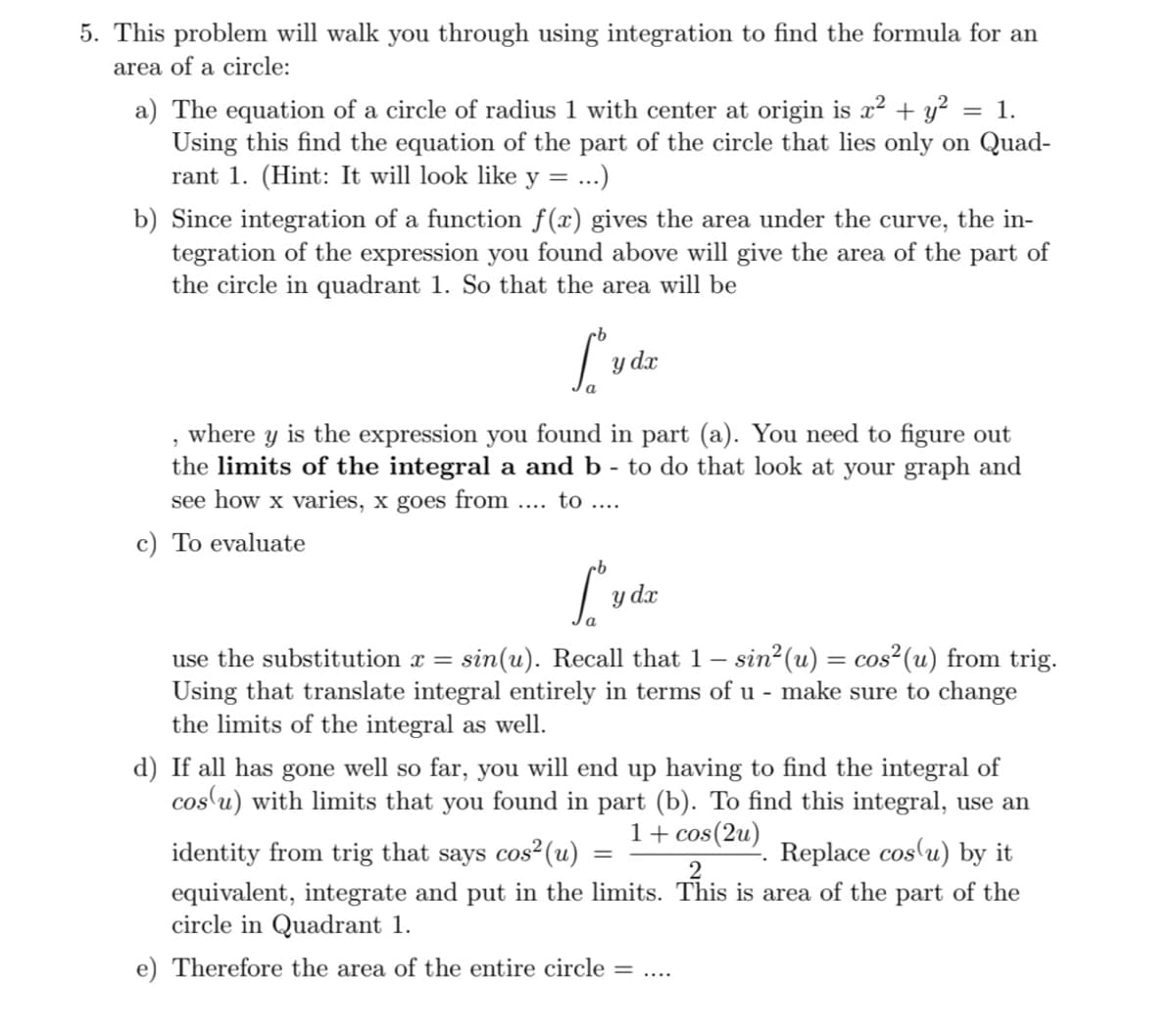5. This problem will walk you through using integration to find the formula for an area of a circle: a) The equation of a circle of radius 1 with center at origin is x2 + y² = 1. Using this find the equation of the part of the circle that lies only on Quad- rant 1. (Hint: It will look like y = ...) b) Since integration of a function f(x) gives the area under the curve, the in-
5. This problem will walk you through using integration to find the formula for an area of a circle: a) The equation of a circle of radius 1 with center at origin is x2 + y² = 1. Using this find the equation of the part of the circle that lies only on Quad- rant 1. (Hint: It will look like y = ...) b) Since integration of a function f(x) gives the area under the curve, the in-
Elementary Geometry For College Students, 7e
7th Edition
ISBN:9781337614085
Author:Alexander, Daniel C.; Koeberlein, Geralyn M.
Publisher:Alexander, Daniel C.; Koeberlein, Geralyn M.
Chapter9: Surfaces And Solids
Section9.3: Cylinders And Cones
Problem 6E: Suppose that r=12 cm and h=15 cm in the right circular cylinder. Find the exact and approximate a...
Related questions
Question
100%
Hi there, please help me with answering this question. I am a bit confused here. It would be appreciated if the question were answered fully and clearly with explanation. Please read the question carefully because sometimes my questions are answered incorrectly and unfortunately I do not receive a refund for them. Please answer with legible handwriting as well. Thank you very much. Thumbs up always given for well explained answers

Transcribed Image Text:5. This problem will walk you through using integration to find the formula for an
area of a circle:
a) The equation of a circle of radius 1 with center at origin is x² + y² :
Using this find the equation of the part of the circle that lies only on Quad-
rant 1. (Hint: It will look like
= 1.
y
.)
b) Since integration of a function f(x) gives the area under the curve, the in-
tegration of the expression you found above will give the area of the part of
the circle in quadrant 1. So that the area will be
y dx
, where y is the expression you found in part (a). You need to figure out
the limits of the integral a and b - to do that look at your graph and
see how x varies, x goes from .. to ....
c) To evaluate
y dr
use the substitution x = sin(u). Recall that 1– sin2(u) = cos²(u) from trig.
Using that translate integral entirely in terms of u - make sure to change
the limits of the integral as well.
d) If all has gone well so far, you will end up having to find the integral of
cos u) with limits that you found in part (b). To find this integral, use an
1+ cos(2u)
Replace cos'u) by it
identity from trig that says cos²(u)
equivalent, integrate and put in the limits. This is area of the part of the
circle in Quadrant 1.
e) Therefore the area of the entire circle =
Expert Solution
This question has been solved!
Explore an expertly crafted, step-by-step solution for a thorough understanding of key concepts.
This is a popular solution!
Trending now
This is a popular solution!
Step by step
Solved in 5 steps

Recommended textbooks for you

Elementary Geometry For College Students, 7e
Geometry
ISBN:
9781337614085
Author:
Alexander, Daniel C.; Koeberlein, Geralyn M.
Publisher:
Cengage,

Elementary Geometry For College Students, 7e
Geometry
ISBN:
9781337614085
Author:
Alexander, Daniel C.; Koeberlein, Geralyn M.
Publisher:
Cengage,